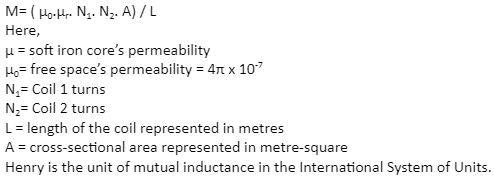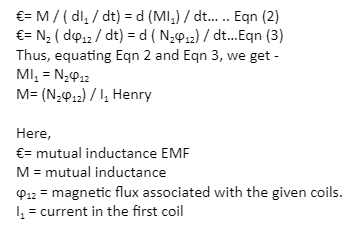When we talk about inductance, we are talking about the property of a device that tells us how effective it can induce an emf in another device. In other words, it is a physical quantity that expresses the effectiveness of a particular piece of equipment.
Theory of Mutual Inductance
Mutual inductance is defined as the interaction of one coil’s magnetic field with the magnetic field of another coil, resulting in a voltage being generated in the surrounding coil. After learning that an inductor’s turns are subjected to a shifting magnetic field in the previous lesson, we know that this induced emf occurs within the device.
Mutual Inductance Formula
The formula of mutual inductance is given as –

Mutual Induction Derivation
Mutual inductance is defined as the interaction of one coil’s magnetic field with the magnetic field of another coil, resulting in a voltage being generated in the surrounding coil. After learning that an inductor’s turns are subjected to a shifting magnetic field in the previous lesson, we know that this induced emf occurs within the device.
Suppose two coils – L1 and L2 have been taken.
Whenever current is passed through the first coil (L1), which alters across time, there is a consequent alteration in the magnetic field.
Thus, the magnetic flux in the second coil (L2) is subject to change.
Electromotive force is induced in L1 owing to magnetic flux density change.
EMF is also produced in the second coil due to the rate of change of current in the first coil. As a result, EMF is induced in the two coils, L1 and L2, connected in series.
The derivation is represented as –

When applying the laws of electromagnetic induction (induced voltage is directly proportional to the rate of change of magnetic flux linked) to the second coil, the induced electromagnetic field is calculated as follows –

Mutual inductance among two coils is determined by the cross-sectional area of the distance between the two coils and the number of turns on the adjacent coil on either side of the distance.
Limitations of Mutual Inductance
- The most significant disadvantage of mutual inductance is that leakage of the inductance of one coil can cause the operation of another coil that is utilising electromagnetic induction.
- To reduce leakage, electrical screening must be installed.
- The amount of mutual inductance between two coils in a circuit is determined by the relative positions of the coils in the circuit.
Conclusion
The emf generated by the magnetic field in one coil, which opposes the change in current and voltage in the other coil, is characterised as inductance between two coils. Because of the change in magnetic flux, the two coils have formed a magnetic link, which means they are magnetically linked together. One coil’s magnetic field or flux interacts with another coil’s magnetic field or flux. Because of the change in magnetic flux, the current flowing in one coil causes the voltage in another coil to change. There is a direct relationship between the amount of magnetic flux associated with the two coils and the mutual inductance and current changes.
 Profile
Profile Settings
Settings Refer your friends
Refer your friends Sign out
Sign out






